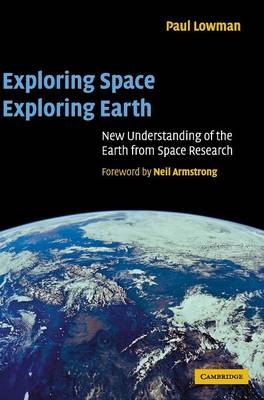
Exploring Space, Exploring Earth
Cambridge University Press (Verlag)
978-0-521-66125-6 (ISBN)
Paul Lowman, a NASA scientist for over 40 years, describes the impact of space flight on geology and geophysics. A foreword by Neil Armstrong emphasizes that the exploration of space has lead us to a far deeper understanding of our own planet. Direct results from Earth-orbital missions include studies of Earth's gravity and magnetic fields. In contrast, the recognition of the economic and biological significance of impact craters on Earth is an indirect consequence of the study of the geology of other planets. The final chapter presents a new theory for the tectonic evolution of the Earth based on comparative planetology and the Gaia concept. Extensive illustrations, a glossary of technical terms, and comprehensive bibliography, provide geologists and geophysicists with a valuable summary of research. The book will also serve as a supplementary text for students of tectonics, remote sensing and planetary science.
Paul Lowman has been involved in a wide range of space research programs at the Goddard Space Flight Center. In 1963–4 he took part in planning for the Apollo missions. He was Principal Investigator for Synoptic Terrain Photography on the Mercury, Gemini, and Apollo earth orbital missions, an experiment that laid the foundation for Landsat. Between 1965 and 1970 he taught lunar geology at the University of California, Catholic University of America, Washington DC, and the Air Force Institute of Technology. Dr Lowman was also involved with the Mariner 9 Mars mission, the Apollo X-ray fluorescence experiment and Apollo 11 and 12 sample analysis among others. His main research interest was and still is the origin of continental crust, as approached through comparative planetology. In 1974, Dr Lowman received the Lindsay Award from the Goddard Space Flight Center. He was elected a Fellow of the Geological Society of America in 1975, and of the Geological Society of Canada in 1988. Drawing on his dual career in terrestrial and lunar geology, he authored Space Panorama (1968), Lunar Panorama (1970), and The Third Planet (1972). He also contributed to Mission to Earth (1976), the first NASA compilation of Landsat pictures edited by N. M. Short.
Foreword Neil Armstrong; Preface; Acknowledgements; 1. Preview of the orbital perspective: the Million Year Day; 2. Space geodesy; 3. Satellite studies of geomagnetism; 4. Remote sensing: the view from space; 5. Impact cratering and terrestrial geology; 6. Comparative planetology and the origin of continental crust; 7. Geology and biology: the influence of life on terrestrial geology; Afterword; Appendix A. Elements of physical geology; Appendix B. Lunar missions, 1958 to 1994; Appendix C. Planetary missions, 1961 to 1992; Glossary of geologic terms; Selected bibliography (by chapter); Index.
| Erscheint lt. Verlag | 15.8.2002 |
|---|---|
| Vorwort | Neil A. Armstrong |
| Zusatzinfo | 6 Tables, unspecified; 27 Plates, color; 46 Halftones, unspecified; 68 Line drawings, unspecified |
| Verlagsort | Cambridge |
| Sprache | englisch |
| Maße | 181 x 255 mm |
| Gewicht | 850 g |
| Themenwelt | Naturwissenschaften ► Geowissenschaften ► Geophysik |
| ISBN-10 | 0-521-66125-0 / 0521661250 |
| ISBN-13 | 978-0-521-66125-6 / 9780521661256 |
| Zustand | Neuware |
| Haben Sie eine Frage zum Produkt? |
aus dem Bereich


